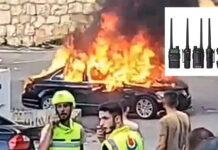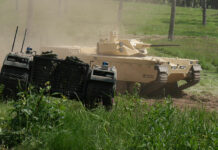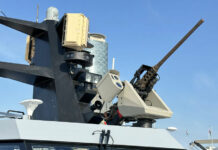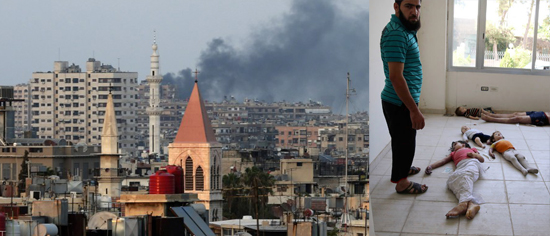
The United States Government announced Friday August 30th that it could say with high confidence that, according to intelligence information it can assess, the Syrian government carried out a chemical weapons attack in the Damascus suburbs on August 21, 2013. “We further assess that the regime used a nerve agent in the attack.” According o U.S. government officials, the assessment provides enough evidence to justify a forceful response by the U.S., deterring Syria and other countries from using unconventional weapons in the future.
According to documents published by the White House, the assessment is based on all-source assessments based on human, signals, and geospatial intelligence as well as a significant body of open source reporting.”Our classified assessments have been shared with the U.S. Congress and key international partners. To protect sources and methods, we cannot publicly release all available intelligence – but what follows is an unclassified summary of the U.S. Intelligence Community’s analysis of what took place.” The White House report said.
Summary:
According to the preliminary U.S. government assessment 1,429 people were killed in the chemical weapons attack that occurred on August 21, 2013 in the vicinity od Damascus, Syria. Casualties included at least 426 children.
“We assess with high confidence that the Syrian government carried out the chemical weapons attack against opposition elements in the Damascus suburbs on August 21.” Ther report said, “We assess that the scenario in which the opposition executed the attack on August 21 is highly unlikely. The body of information used to make this assessment includes intelligence pertaining to the regime’s preparations for this attack and its means of delivery, multiple streams of intelligence about the attack itself and its effect, our post-attack observations, and the differences between the capabilities of the regime and the opposition. Our high confidence assessment is the strongest position that the U.S. Intelligence Community can take short of confirmation. We will continue to seek additional information to close gaps in our understanding of what took place.”
In addition to U.S. intelligence information, there are accounts from international and Syrian medical personnel; videos; witness accounts; thousands of social media reports from at least 12 different locations in the Damascus area; journalist accounts; and reports from highly credible nongovernmental organizations.
The Syrian regime has initiated an effort to rid the Damascus suburbs of opposition forces using the area as a base to stage attacks against regime targets in the capital. The regime has failed to clear dozens of Damascus neighborhoods of opposition elements. Despite employing nearly all of its conventional weapons systems the regime failed to clear hose neighborhoods of the opposition. “We assess that the regime’s frustration with its inability to secure large portions of Damascus may have contributed to its decision to use chemical weapons on August 21.” The report said.
“We assess that the Syrian regime has used chemical weapons over the last year primarily to gain the upper hand or break a stalemate in areas where it has struggled to seize and hold strategically valuable territory.” The report determined, “In this regard, we continue to judge that the Syrian regime views chemical weapons as one of many tools in its arsenal, including air power and ballistic missiles, which they indiscriminately use against the opposition.” The White House report concludes.
Syrian Chemical Attack Capabilities:
The Syrian regime maintains a stockpile of numerous chemical agents, including mustard, sarin, and VX and has thousands of munitions that can be used to deliver chemical warfare agents.
Syrian President Bashar al-Asad is the ultimate decision maker for the chemical weapons program and members of the program are carefully vetted to ensure security and loyalty. The Syrian Scientific Studies and Research Center (SSRC) – which is subordinate to the Syrian Ministry of Defense – manages Syria’s chemical weapons program.
We assess with high confidence that the Syrian regime has used chemical weapons on a small scale against the opposition multiple times in the last year, including in the Damascus suburbs. This assessment is based on multiple streams of information including reporting of Syrian officials planning and executing chemical weapons attacks and laboratory analysis of physiological samples obtained from a number of individuals, which revealed exposure to sarin. We assess that the opposition has not used chemical weapons.
The detection of rocket launches from regime controlled territory early in the morning, approximately 90 minutes before the first report of a chemical attack appeared in social media.
The Syrian regime has the types of munitions that we assess were used to carry out the attack on August 21, and has the ability to strike simultaneously in multiple locations. We have seen no indication that the opposition has carried out a large-scale, coordinated rocket and artillery attack like the one that occurred on August 21.
Preparation:
We have intelligence that leads us to assess that Syrian chemical weapons personnel – including personnel assessed to be associated with the SSRC – were preparing chemical munitions prior to the attack. In the three days prior to the attack, we collected streams of human, signals and geospatial intelligence that reveal regime activities that we assess were associated with preparations for a chemical weapons attack.
Syrian chemical weapons personnel were operating in the Damascus suburb of ‘Adra from Sunday, August 18 until early in the morning on Wednesday, August 21 near an area that the regime uses to mix chemical weapons, including sarin. On August 21, a Syrian regime element prepared for a chemical weapons attack in the Damascus area, including through the utilization of gas masks. Our intelligence sources in the Damascus area did not detect any indications in the days prior to the attack that opposition affiliates were planning to use chemical weapons.
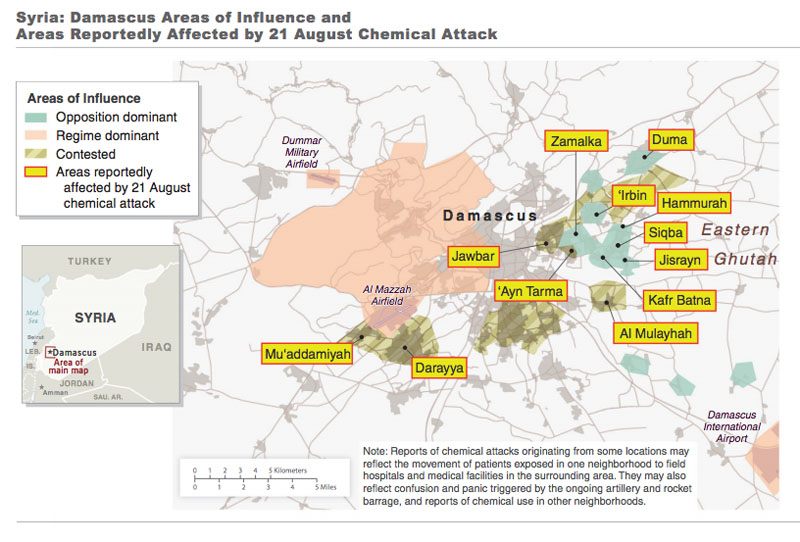
The Attack:
Multiple streams of intelligence indicate that the regime executed a rocket and artillery attack against the Damascus suburbs in the early hours of August 21. Satellite detections corroborate that attacks from a regime-controlled area struck neighborhoods where the chemical attacks reportedly occurred – including Kafr Batna, Jawbar, ‘Ayn Tarma, Darayya, and Mu’addamiyah. This includes the detection of rocket launches from regime controlled territory early in the morning, approximately 90 minutes before the first report of a chemical attack appeared in social media. The lack of flight activity or missile launches also leads us to conclude that the regime used rockets in the attack.
Local social media reports of a chemical attack in the Damascus suburbs began at 2:30 a.m. local time on August 21. Within the next four hours there were thousands of social media reports on this attack from at least 12 different locations in the Damascus area. Multiple accounts described chemical-filled rockets impacting opposition-controlled areas.
We intercepted communications involving a senior official intimately familiar with the offensive who confirmed that chemical weapons were used by the regime on August 21 and was concerned with the U.N. inspectors obtaining evidence.
Three hospitals in the Damascus area received approximately 3,600 patients displaying symptoms consistent with nerve agent exposure in less than three hours on the morning of August 21, according to a highly credible international humanitarian organization. The reported symptoms, and the epidemiological pattern of events – characterized by the massive influx of patients in a short period of time, the origin of the patients, and the contamination of medical and first aid workers – were consistent with mass exposure to a nerve agent. We also received reports from international and Syrian medical personnel on the ground.
We have identified one hundred videos attributed to the attack, many of which show large numbers of bodies exhibiting physical signs consistent with, but not unique to, nerve agent exposure. The reported symptoms of victims included unconsciousness, foaming from the nose and mouth, constricted pupils, rapid heartbeat, and difficulty breathing. Several of the videos show what appear to be numerous fatalities with no visible injuries, which is consistent with death from chemical weapons, and inconsistent with death from small-arms, high-explosive munitions or blister agents. At least 12 locations are portrayed in the publicly available videos, and a sampling of those videos confirmed that some were shot at the general times and locations described in the footage.
We assess the Syrian opposition does not have the capability to fabricate all of the videos, physical symptoms verified by medical personnel and NGOs, and other information associated with this chemical attack.
We have a body of information, including past Syrian practice, that leads us to conclude that regime officials were witting of and directed the attack on August 21. We intercepted communications involving a senior official intimately familiar with the offensive who confirmed that chemical weapons were used by the regime on August 21 and was concerned with the U.N. inspectors obtaining evidence. On the afternoon of August 21, we have intelligence that Syrian chemical weapons personnel were directed to cease operations. At the same time, the regime intensified the artillery barrage targeting many of the neighborhoods where chemical attacks occurred. In the 24 hour period after the attack, we detected indications of artillery and rocket fire at a rate approximately four times higher than the ten preceding days. We continued to see indications of sustained shelling in the neighborhoods up until the morning of August 26.
To conclude, there is a substantial body of information that implicates the Syrian government’s responsibility in the chemical weapons attack that took place on August 21. As indicated, there is additional intelligence that remains classified because of sources and methods concerns that is being provided to Congress and international partners.


